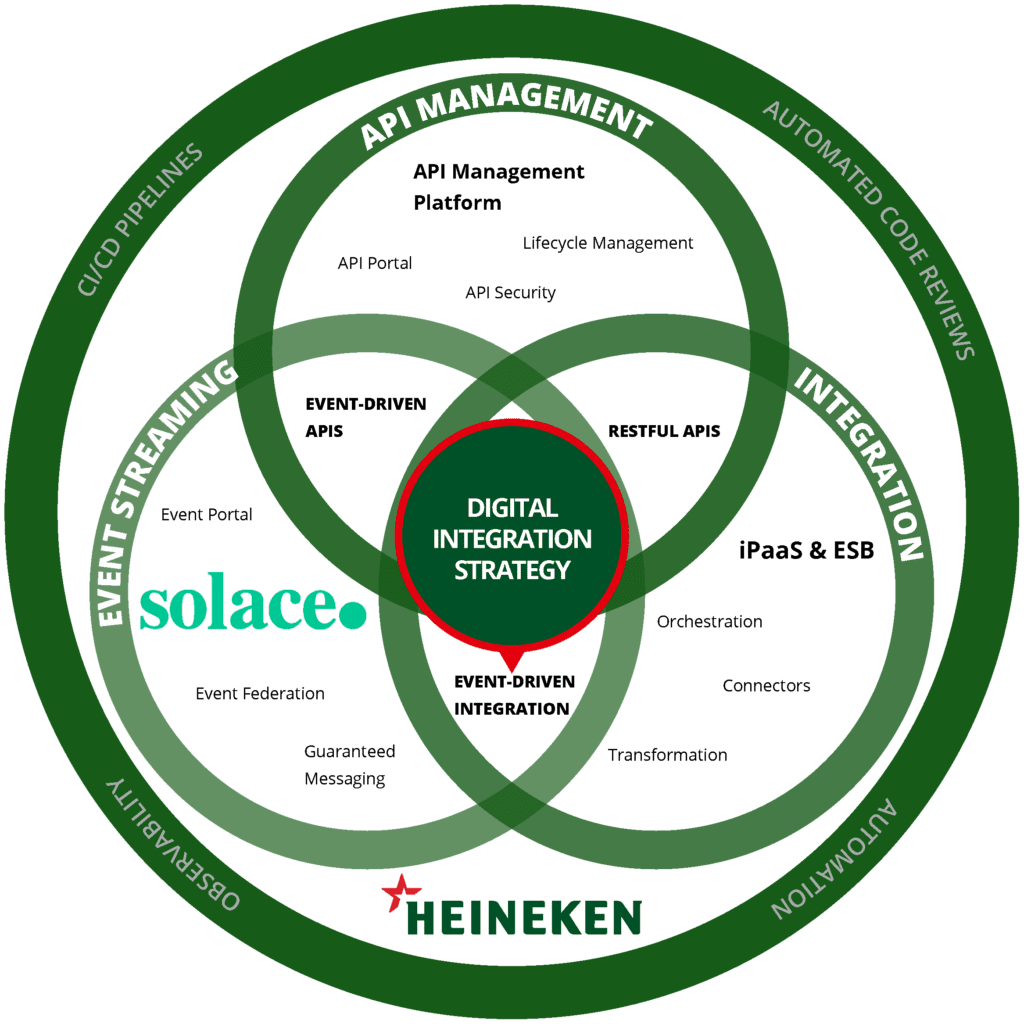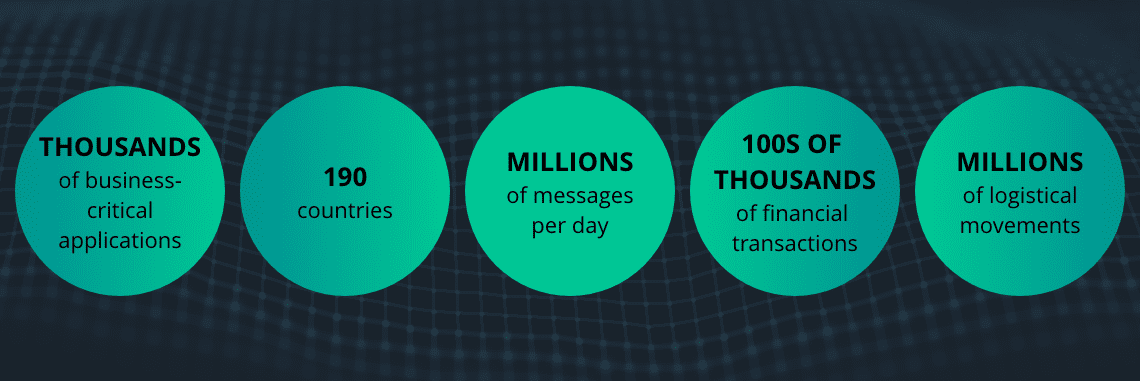Read the post in Lire le communiqué de presse en
HEINEKEN’s EverGreen business strategy aims to increase the company’s resilience and adaptability in order to meet the demands of a fast-changing world. It highlights the importance of customer centricity, productivity, and digitalizing the business – urgently – to navigate and grow through inevitable turbulence and change.
In support of the EverGreen strategy, HEINEKEN’s Global IT organization is focused on connecting:
- Thousands of business-critical applications across payments, logistics, inventory management, and more.
- Dozens of operating companies (OpCos), many of which maintain their local (sometimes original) business systems.
- Business units in more than 190 countries where Heineken® beer and cider are sold, with many that continue to manufacture local beverage brands (~350 global and local brands in total).
Guus Groeneweg, Product Owner for Digital Integration explains:
To me, becoming the Best Connected Brewer means providing all our internal and external customers with real-time access to data provided through our integration assets, and ensuring those integration processes work effectively, consistently, without disruption.”
Guus Groeneweg, Global Product Owner for Digital Integration

To overcome these challenges and meet their ambitious digital transformation targets, HEINEKEN is taking an event-driven approach to integration. In short, they are underpinning their modern integration and API management technologies with a dynamic and robust event streaming layer that will:
- Deliver crucial data from external parties/apps throughout the enterprise;
- Prevent data loss and system failures by absorbing bursts of events;
- Guarantee business continuity in the face of a cloud or iPaaS outage; and
- Support future use cases that benefit from/demand real-time, event-driven data movement, such as mobile ordering.
I recently had the chance to ask Guus a few questions about this integration strategy and the results he’s seen so far.
Guus, can you share more context around your decision to make event-driven integration a core component of your integration strategy?
I would be lying if I said that ‘event-driven integration’ was part of our master plan all along; it’s really been a journey to this point. At the start most, if not all, of our integrations were batch-based, point-to-point in nature, and safely within our data centers. But about five years ago we started to implement cloud integration platforms and API management capabilities to handle the increased volumes for our fast-growing e-business initiatives.
Two years ago, we started to face challenges related to the increasing volume of orders we were receiving. It was putting pressure on our cloud integration infrastructure and resulting in some duplicate and lost orders, so we had to solve that problem ASAP. That’s what led us to event-driven integration, and to Solace. We put Solace PubSub+ event brokers in front of our integration technologies to make our integration processes more robust and reliable.
This approach has also helped us become more efficient in what data we move, and how. In the past we’d see hundreds or thousands of these point-to-point scenarios. Now that we are leveraging the 1-to-many integration patterns, an application only has to produce an event (like and order of beer) once, and any other applications in the system (production, shipping, fulfillment, inventory, payments, cloud data lake etc.) can just subscribe to what they want to receive, and get it when it’s published.
Event Driven Integration with iPaaS - The Architect's Guide to ImplementationIn this guide, you will learn how pairing an iPaaS with an event broker will help you create a robust and scalable architecture and the technical steps you need to take to start reaping the benefits of event-driven integration
We are also leveraging event-driven integration to increase the efficiency of our application development process – with the event broker in the mix, our app teams can just focus on designing great apps and not worry about the messaging or event streaming infrastructure.
There will be many more use cases down the road, across IoT, analytics, customer facing apps and more. Event-driven integration is really a core strategic capability for us moving forward.
Taking a step back, how much of your event-driven integration strategy is vision versus reality today?
Each and every capability of our digital integration strategy is in place. We enable all required integration patterns through a limited set of integration platforms, from interfaces between local systems in Vietnam up to interfaces from Global ERP Systems to local CRM systems. The main area where we are currently focusing on is moving towards reusable integration assets.
That is really required, with some big standardization programs we are now deploying to more than 190 countries. Moving away from 70+ different ERP instances with different data models and process definitions to a lean core with a loosely coupled yet tightly integrated architecture; from a large set of fragmented solutions to modern cloud-based platforms that optimize end to end ways of working in specific area.
Can you share some examples of event-driven integration in action?
Sure. Consider this chain of events: A large supermarket chain in New Zealand places orders through our B2B portal, the order is processed in the back-end with the payment information, the beer is delivered, the packing lists in the brewery have to roll out of the label printer, etc. Each of these activities are supported by multiple integrations between front- and back-end.
My team makes sure the whole end-to-end process works right. Integration is the glue for all this — it’s what allows all of the processes and applications in the value chain to communicate.
All these digital integrations are developed, operated, and monitored by the global digital integration team.
Share this post with your Twitter networkHow has event-driven integration benefitted your business?
There are three categories of value that event-driven integration unlocks for HEINEKEN:
- Enabling critical business insights at scale (advanced analytics, machine learning, AI).
- Superfluid experiences for customers, consumers, suppliers and employees.
- Scalable “plug and play” solutions deployed quickly.
But if you zoom in more towards OpCos and our customers, there has been an enormous paradigm shift. Just a few years ago, integration in HEINEKEN was a utility; it was simply enough to move files from one location to another – and if that took an hour, everybody was happy.
Today, customer experience drives differentiation. The need for real-time, secure transactions anywhere in the 190 countries in which HEINEKEN is active has changed integration into an enabler.
If you order your groceries at home, you don’t want to wait 13 seconds before your payment is processed, right? The same goes exactly for all our customers and consumers!
What does the future hold for event-driven integration at HEINEKEN?
Our ultimate goal is to build seamless digital interactions across the entire value chain, and provide all HEINEKEN solution owners internally, and our partners externally, all of the information they need to make smart decisions. In order to achieve this, we are using event-driven integration to deploy a global observability solution that makes data-driven insights available to operational teams in real-time. This allows us to instantly feed our business with the right data, for the right consumer, with the right application at the time they need it.
Our Global Digital Integration team is responsible for maintaining over 4,000 interfaces worldwide and ensuring the distribution of tens of millions of messages per month. And those numbers are growing every day. We can’t afford to lose any of these messages, they all provide value – enabling B2B customers to digitally connect to HEINEKEN to place orders, empowering our sales force, and ultimately, they enables us to realize our “connected bar” strategy with ePOS deployments in key markets.
Conclusion
Like many large organizations with a globally distributed supply chain, customer base, workforce, and IT infrastructure, HEINEKEN is on a digital transformation journey to become a better connected business. Through this transformation, they hope to drive new operational efficiencies, better customer experiences, and accelerated innovation. This journey is taking place within – and in large part motivated by – the unprecedented disruptions of our time (climate change, COVID-19, changing business models, etc.).
The shape and execution of their digital integration strategy is critical to meeting those objectives, and it appears they are on the right track.
If you have any questions about how event-streaming, event-driven architecture, and event-driven integration can support your digital integration strategy, I encourage you to book a free consultation with one of our experts.
About HEINEKEN N.V.
HEINEKEN is a Dutch brewing company, founded in 1864 by Gerard Adriaan Heineken in Amsterdam. HEINEKEN currently owns over 165 breweries in more than 70 countries. It produces 300+ international, regional, local and specialty beers and ciders and employs approximately 80,000 people.
Explore other posts from categories: For Architects | Use Cases

 Chris Wolski
Chris Wolski


